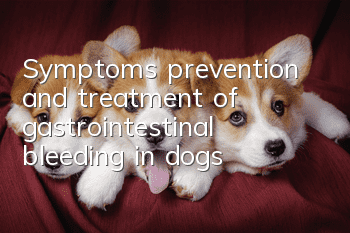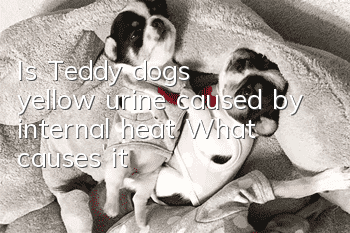Symptoms, prevention and treatment of gastrointestinal bleeding in dogs

Gastrointestinal bleeding in dogs is an acute gastroenteritis syndrome, and its cause is not yet clear. The disease is characterized by sudden onset, rapid death, vomiting, diarrhea, and the discharge of peptone-like mucus and bloody stools.
Bordeaux Dog
It can occur in dogs of all ages and breeds, with no gender difference, but it mostly occurs in small purebred dogs aged 2 to 4 years old.
Symptoms of gastrointestinal bleeding in dogs:
In the absence of any obvious predisposing factors, the disease occurs suddenly, and the sick dog vomits, has diarrhea, and loses weight rapidly. In severe cases, it discharges jelly-like mucus and bloody stools, and the blood is bright red or dark red with a fishy smell
Sick dogs are depressed, have no appetite, are dehydrated, and have thick blood. If not treated in time, they often die within 1 to 2 days due to blood circulation disorders and shock.
[Diagnosis] A preliminary diagnosis can be made based on the medical history and clinical symptoms. In acute cases, due to dehydration and thick blood, the hematocrit is significantly increased, usually greater than 60%, or even as high as 80%, which has important diagnostic reference significance. However, attention should be paid to distinguishing this disease from canine parvovirus disease: (1) the texture of feces is different; (2) canine parvovirus disease is highly contagious; (3) canine infectious enteritis has an elevated body temperature.
Treatment of gastrointestinal bleeding in dogs
1. Rehydration: Use 50-60ml/kg of Ringer's solution, add 50% glucose to make it a concentration of 5%, and infuse intravenously once a day. Give oral rehydration salt to sick dogs whose vomiting is not serious but have a desire to drink and let them drink it on their own. In cases with high hematocrit value, low molecular weight dextran solution can be intravenously infused at 20ml/kg to reduce the hematocrit value.
2. Cardiotonic drugs can be used to protect the heart during the infusion process, such as poison K, 0.125 to 0.25 mg for the first time, added to 40 ml of glucose liquid for infusion, and repeated after 1 to 2 hours. Or sodium benzoate, caffeine 0.1~0.4g, intramuscular injection, or Shengmai needle 1~2ml, VB12 0.5mg mixed intramuscular injection
3. For hemostasis and anti-allergy, use VK1 1ml and VK3 2ml for intramuscular injection together with 2ml of Hemostasis or Anluoxue 1ml twice a day. At the same time, use desammethasone, 5 to 10mg per dog, twice a day, intramuscularly. .
4. To control secondary infection, ampicillin 20 mg/kg, intramuscular injection, kanamycin, 300,000 to 500,000, intramuscular injection, twice a day, berberine can also be taken orally, 4 to 5 tablets each time, 3 to 4 times a day. , Medicamycin, 1 to 2 tablets each time, 2 to 3 times a day. ;
5. Symptomatic treatment for severe vomitingIn cases of severe diarrhea, 2ml of VB6 and 0.5 to 2ml of Amor can be injected intramuscularly, twice a day. For severe cases of diarrhea, 0.3 to 0.9g of tannic acid protein, 10mg of VB1, 2mg of Vk4, 20mg/kg of norfloxacin, and 0.5g of sodium bicarbonate can be used. , take it orally once, 3 times a day, and you can get the desired effect.
(1) Diagnosis: Acute hemorrhagic gastroenteritis is a syndrome of unknown cause in dogs. It is characterized by sudden onset, vomiting, bloody diarrhea and obvious hemoconcentration in severe cases. Acute hemorrhagic gastroenteritis is not a true inflammatory disease. It lacks the lesions of general inflammation. It is essentially an intestinal functional disorder caused by changes in mucosal permeability or secretion. Sick dogs often vomit suddenly and develop severe bloody diarrhea a few hours later, with foul-smelling feces. Depression and prolonged capillary refill time. Precipitating factors for the disease are often not found in the medical history. If not treated in time, death often occurs within a few hours due to circulatory failure and shock. If treated promptly, the mortality rate is not high. The most diagnostic indicator of this disease is hematocrit. In acute hemorrhagic gastroenteritis, the hematocrit is significantly elevated (usually greater than 60%, and some can be as high as 80%), and foul-smelling bloody diarrhea occurs.
(2) Treatment: Acute hemorrhagic gastroenteritis should be treated as an emergency. Timely and massive infusion can prevent death. In the initial stage, infuse isotonic saline, and in the later stage, infuse 2 parts of isotonic saline plus 1 part of isotonic glucose solution, and appropriately add 10% low molecular weight dextran solution. It is best to use intravenous cannula for infusion. Start a rapid infusion of 90 ml per kilogram of body weight until capillary filling returns to normal; when the red blood cells rise to above 50%, infuse 40 to 60 ml of fluid per kilogram of body weight after 24 hours to maintain the hematocrit. Below 50%, if there is shock and does not respond well to intravenous infusion treatment, corticosteroids may be considered. Feeding and drinking should be prohibited for the first 24 hours, and when the vomiting and bloody loose stools stop, a small amount of light food can be given. If there is still no effect after 24 hours of this treatment, you should consider whether it is caused by other diseases, such as canine parvovirus infection, intussusception, volvulus, etc.
Recommended Good Things
Aineng Pet Odor Eliminating Disinfectant can effectively remove body odor/feces odor and other odor molecules! Effectively treats skin diseases caused byfungi/bacteria! Can killparvovirus/canine distemper virus/coronavirusetc.!
It is edible grade for pets, does not contain fragrances, does not contain chemicals, can be sprayed directly, and is harmless to human pets!
Consultation:13028809308 (WeChat synchronization)
Scan the QR code on WeChat to enter the purchase
- What's the matter with dogs eating grass?
- How about super believable? Is deworming effective for dogs?
- How to train a Greyhound to stare at a light? Tips for training a Greyhound to stare at a light!
- What should you pay attention to when vaccinating your dog? Precautions for dog vaccination!
- What should I do if my Greenland dog vomits after eating too much?
- Come and see how many of these pet-raising misunderstandings you have fallen into?
- How to cool down your dog in summer, teach you how to make your own dog ice cream!
- Can dogs drink Huoxiang Zhengqi water if they have heat stroke?
- What are the solutions to dogs’ bad mouth?
- How many days does it take for a newborn puppy to walk?



